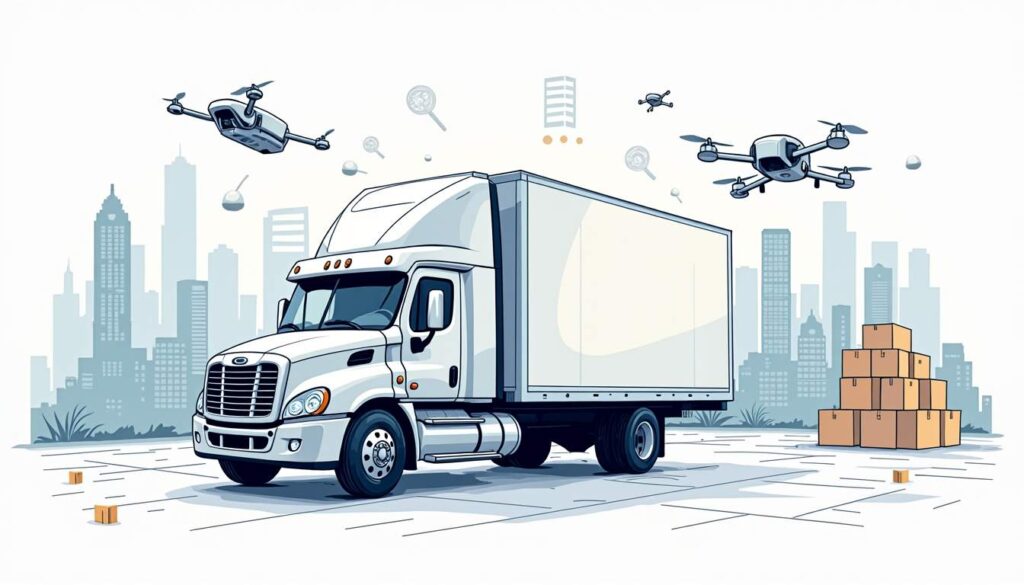The landscape of transportation and logistics is undergoing a seismic shift, driven by advancements in artificial intelligence (AI) and automation. These technologies are not just enhancing existing processes; they are redefining the very essence of how goods and people move from one place to another. As we delve into the future of moving, it becomes clear that the integration of AI and automation is set to revolutionize the industry in ways previously unimaginable.
Understanding AI and Automation in Transportation
At its core, AI refers to the simulation of human intelligence in machines, enabling them to perform tasks that typically require human cognition. Automation, on the other hand, involves using technology to perform tasks with minimal human intervention. Together, these technologies are streamlining operations, improving efficiency, and enhancing safety in transportation.
AI-Powered Decision Making
One of the most significant contributions of AI in transportation is its ability to analyze vast amounts of data quickly and accurately. This capability allows for improved decision-making processes. For instance, AI algorithms can predict traffic patterns, optimize delivery routes, and even forecast demand for specific services. By leveraging these insights, companies can reduce operational costs and improve customer satisfaction.
Moreover, AI can help in real-time decision-making. For example, if a delivery vehicle encounters an unexpected road closure, AI systems can instantly reroute the vehicle, ensuring timely deliveries while minimizing disruptions. This level of responsiveness is crucial in today’s fast-paced world, where customer expectations are higher than ever. Additionally, AI’s predictive capabilities extend beyond immediate logistics; they can also inform long-term strategies, helping businesses anticipate market shifts and adapt accordingly.
Automation in Logistics and Delivery
Automation is also making waves in logistics and delivery services. Automated warehouses equipped with robotics can handle inventory management, packing, and shipping with remarkable efficiency. These systems can operate 24/7, significantly reducing the time it takes to fulfill orders.
In addition, the rise of autonomous vehicles is transforming the delivery landscape. Companies are experimenting with self-driving delivery vans and drones, which can navigate urban environments and deliver packages directly to consumers’ doorsteps. This not only reduces labor costs but also addresses the challenges of last-mile delivery, a critical aspect of the logistics chain. Furthermore, the integration of AI with automation in these vehicles enhances their navigation systems, allowing them to adapt to changing road conditions and optimize their routes in real-time, thereby increasing their reliability and effectiveness.
Moreover, the implementation of automation in transportation is not limited to just delivery services. Public transportation systems are also benefiting from these advancements. Smart traffic lights, for instance, can adjust their timing based on real-time traffic data, improving flow and reducing congestion. Similarly, AI-driven analytics can help transit authorities optimize schedules and routes based on passenger demand, ensuring that services are both efficient and responsive to the needs of the community. As these technologies continue to evolve, the potential for smarter, more connected transportation systems becomes increasingly tangible, promising a future where mobility is seamlessly integrated with the latest technological advancements.
The Impact on Urban Mobility
As cities grow and populations increase, urban mobility becomes a pressing concern. AI and automation are poised to address these challenges by providing innovative solutions that enhance the efficiency of public transportation systems and reduce congestion.
Smart Public Transportation Systems
AI is being integrated into public transportation systems to create smarter, more responsive services. For example, AI can analyze ridership patterns and adjust bus and train schedules accordingly. This ensures that transportation services are aligned with actual demand, reducing wait times and improving the overall user experience.
Additionally, AI-driven apps can provide real-time updates to commuters, helping them make informed decisions about their travel routes. By offering alternative options and suggesting the fastest ways to reach their destinations, these technologies are making public transportation more appealing and user-friendly.
Reducing Traffic Congestion
Traffic congestion is a significant issue in urban areas, leading to wasted time and increased pollution. AI can play a vital role in alleviating this problem by optimizing traffic flow. Intelligent traffic management systems can analyze data from various sources, including traffic cameras and sensors, to adjust traffic signals in real-time.
Furthermore, AI can facilitate carpooling and ridesharing services by connecting drivers with passengers heading in the same direction. This not only reduces the number of vehicles on the road but also promotes a more sustainable approach to urban mobility.
Enhancing Safety and Security
Safety is a paramount concern in the transportation industry, and AI and automation are making significant strides in this area. From predictive maintenance to advanced driver-assistance systems, these technologies are enhancing safety for both passengers and drivers.
Predictive Maintenance
AI can analyze data from vehicles to predict when maintenance is required, reducing the likelihood of breakdowns and accidents. By monitoring various parameters, such as engine performance and tire pressure, AI systems can alert operators to potential issues before they escalate. This proactive approach not only enhances safety but also extends the lifespan of vehicles.
Advanced Driver-Assistance Systems (ADAS)
ADAS technologies are becoming increasingly common in modern vehicles. These systems utilize AI to assist drivers in various ways, such as lane-keeping assistance, adaptive cruise control, and automatic emergency braking. By providing real-time feedback and support, ADAS can help prevent accidents and enhance overall road safety.
Challenges and Considerations
While the benefits of AI and automation in transportation are substantial, there are also challenges and considerations that must be addressed. Issues such as data privacy, cybersecurity, and the potential for job displacement are critical factors that require careful examination.
Data Privacy and Security
The integration of AI in transportation relies heavily on data collection and analysis. This raises concerns about data privacy and security. Companies must ensure that they are handling personal data responsibly and in compliance with regulations. Implementing robust cybersecurity measures is essential to protect sensitive information from potential breaches.
Job Displacement and Workforce Transition
The rise of automation in transportation may lead to job displacement in certain sectors. As self-driving vehicles and automated systems become more prevalent, workers in traditional roles may find themselves at risk. It is crucial for companies and governments to invest in workforce transition programs that provide retraining and upskilling opportunities for affected individuals.
The Road Ahead: Future Innovations
The future of moving holds immense potential as AI and automation continue to evolve. Innovations on the horizon promise to further transform transportation and logistics, making them more efficient, sustainable, and user-friendly.
Electric and Autonomous Vehicles
The shift towards electric and autonomous vehicles is gaining momentum. As battery technology improves and charging infrastructure expands, electric vehicles are becoming more accessible and practical. Coupled with autonomous driving technology, these vehicles have the potential to reduce emissions and revolutionize personal and commercial transportation.
Moreover, the combination of AI and electric vehicles can lead to smarter energy management. AI systems can optimize charging schedules based on demand and grid conditions, ensuring that electric vehicles are charged efficiently and sustainably.
Hyperloop and Advanced Transit Systems
Beyond traditional modes of transportation, concepts like the Hyperloop are being explored as the future of high-speed travel. This innovative transportation system aims to transport passengers in pods through low-pressure tubes at incredible speeds. AI will play a vital role in managing these systems, ensuring safety and efficiency while minimizing energy consumption.
Conclusion
The future of moving is undeniably exciting, with AI and automation at the forefront of this transformation. As these technologies continue to evolve, they promise to reshape the way goods and people are transported, creating a more efficient, safe, and sustainable future. While challenges remain, the potential benefits of embracing AI and automation in transportation are too significant to ignore. As the industry adapts to these changes, it will be crucial to prioritize ethical considerations, workforce transitions, and data security to ensure that the future of moving is not only innovative but also inclusive and responsible.
















